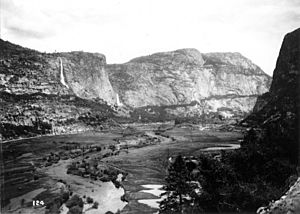Raker Act facts for kids
The Raker Act was a special law passed by the United States Congress in 1913. It allowed the building of the O'Shaughnessy Dam. This dam created a large lake in the Hetch Hetchy Valley, which was part of Yosemite National Park in California. The law is named after John E. Raker, who was its main supporter.
The Act said that since the water and power came from public land, no private company could make a profit from it. A famous conservationist named John Muir fought against damming the valley for many years. The dam was finally finished in 1923.
People have often said that the Raker Act is being broken because private companies are making money from the project. There have also been several efforts to remove the dam and bring the Hetch Hetchy Valley back to its natural state.
Contents
Why the Raker Act Was Needed
The idea for the Raker Act started in 1882. A company wanted to bring water from the Tuolumne River to San Francisco. At that time, San Francisco was growing very fast. But it needed more water to keep growing.
The city also wanted to stop the Spring Valley Water Company from having a complete control over water supply. City leaders thought the Hetch Hetchy Valley would be perfect for a reservoir. It was close to San Francisco and had lots of water from the snowy Sierra Nevada mountains. Building a dam there would also create electricity for the city.
Hetch Hetchy and Yosemite National Park
There was a big problem: the Hetch Hetchy Valley was inside the new Yosemite National Park. Mayor James Phelan of San Francisco asked Congress to let the city buy the land. This led to the 1901 Right of Way Act. This law allowed the government to set aside public lands for water if it helped the public and not private businesses.
After this law, Mayor Phelan gave his water rights in Hetch Hetchy to San Francisco. The city then asked for permission to build their water project. But the Secretary of the Interior, Ethan Hitchcock, said no. He believed Yosemite National Park should stay wild and untouched.
The 1906 Earthquake and Water Needs
In 1906, a huge earthquake hit San Francisco. About 500 city blocks were destroyed by the quake and fires. This event showed how much the city needed more water. After the earthquake, San Francisco leaders pushed even harder to get permission for the Hetch Hetchy Valley.
In 1908, a new Secretary of the Interior, James Rudolph Garfield, changed the earlier decision. He gave San Francisco permission to buy the land in Yosemite National Park. Garfield thought Hetch Hetchy was not that special. He believed a lake there would look nice. He also thought the money from electricity would pay for the dam.
Getting Congress to Approve
Garfield's decision was not final. Future Secretaries could change it. So, San Francisco needed Congress to make their right to build in Yosemite permanent. In late 1908, San Francisco citizens approved $600,000 to buy land and water rights in Hetch Hetchy. They also approved $45,000,000 in 1910 to build all the water systems.
Two later Secretaries of the Interior, Richard A. Ballinger and Walter Fisher, did not want the dam built in Hetch Hetchy. They suggested San Francisco use other places like Lake Eleanor and Cherry Valley. These places were considered less important for nature.
However, in 1912, an expert named John R. Freeman said that building in Hetch Hetchy would be much cheaper and provide more water. In 1913, Woodrow Wilson became president. He asked Congress to look at San Francisco's request. On September 3, 1913, the House of Representatives passed a bill by John Raker. This bill allowed San Francisco to use Hetch Hetchy Valley and Lake Eleanor for water. The bill then passed in the U.S. Senate on December 2, 1913. President Wilson signed it on December 19. It was named the Raker Act after John Raker.
Efforts to Protect Hetch Hetchy Valley
The San Francisco Bay Guardian newspaper spent many years reporting on claims that the Raker Act was being broken. They said that San Francisco sold the electricity to PG&E. Then PG&E sold it back to the public for a profit. This was against the Act.
Harold L. Ickes from the Roosevelt Interior Department tried for many years to make sure the Raker Act was followed. But he was not successful.
In the 1980s, Donald P. Hodel, who was Secretary of the Interior under President Reagan, tried to remove the dam. In 2003, the George W. Bush Administration also tried to get money to study removing the dam and bringing the Hetch Hetchy Valley back to its natural state.
Images for kids
See also
 In Spanish: Ley Raker para niños
In Spanish: Ley Raker para niños



